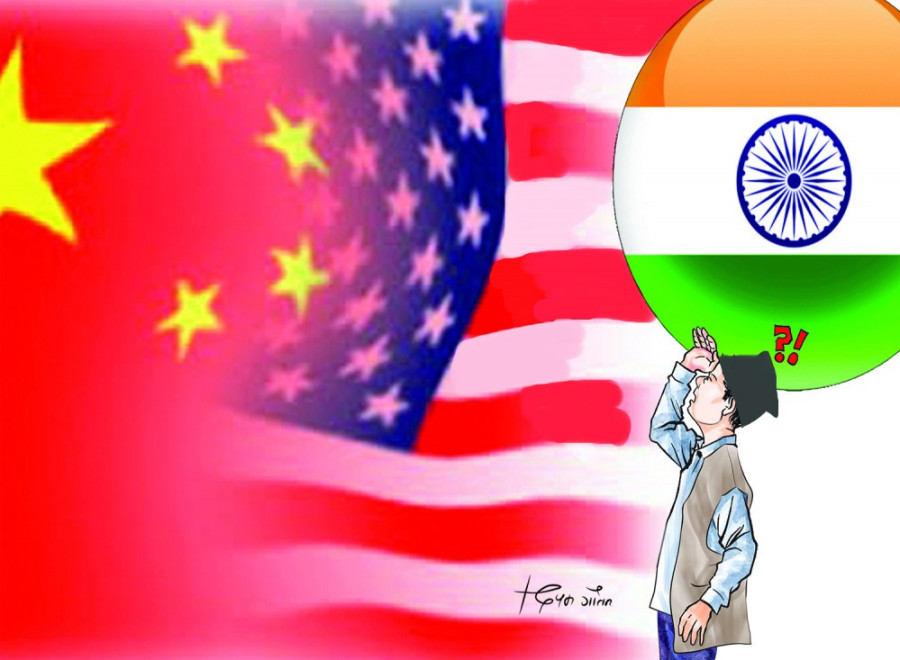Columns
Geoeconomics over geopolitics
Nepal faces challenges in managing diplomacy on three levels—global, regional and bilateral.
Achyut Wagle
On Monday, United States Secretary of State Antony Blinken concluded his visit to China, the first by an American secretary of state in the last five years. The US described Sunday's talks with Chinese counterpart Qin Gang which lasted five and a half hours as “candid, substantive and constructive”. The Chinese propaganda machine too called the discussions “candid, in-depth and constructive”. The US strategy of diplomatic engagement comes at a time when relations between the world's two largest economies are at their lowest point since 1979. Relations rapidly deteriorated in recent years primarily over the question of Taiwan which Beijing views as “the core of China's core interests, the most consequential issue and the most pronounced risk in China-US relations.”
There were global apprehensions that the Taiwan issue might escalate into a full-blown military conflict with instant ramifications on the international supply chain, financial markets and global security. The biggest achievement of Blinken's China sojourn is the agreement to continue the “conversation” in the future. Observers feared that the global economy, already feeling intense heat from the protracted Russia-Ukraine war, might face another deadly shock if any form of conflict involving the two largest economies began in the South China Sea, the world's busiest maritime corridor.
But the fact is that despite the adamant diplomatic posturing and intense competition for geopolitical influence, both sides have deeper economic interests which they are not prepared to forsake. US-China trade is poised to cross $700 billion in 2023, making China America's largest single country trade partner surpassing Canada and Mexico. The merchandise trade balance is heavily skewed in China's favour. This is the reason why Blinken and Qin agreed to “encourage more people-to-people and educational exchanges, increase the passenger flights between the two countries and to welcome more mutual visits by students, scholars and business people.” The US has a huge Chinese diaspora and China is host to hundreds of American multinational companies. US foreign direct investment stock in China is valued at about $2 trillion.
Regional dimension
Although these high diplomatic dramas of the superpowers are out of Nepal's league, she is destined to be at the receiving end of their inevitable outcomes. Situated between China and another global power India, Nepal also enjoys 75 years old relations with the US. When all these great powers and many others choose to compete instead of cooperating, Nepal is left to do a precarious balancing act which is proving to be impossible to perform. Nepal is constantly faced with challenges in managing diplomacy on three levels—global, regional and bilateral.
Western democracies are keen on containing Chinese “advances” in the form of economic and cultural engagements in Nepal. There are allegations that the West uses Nepal as a point to peep into China.
The increasingly fierce competition between China and India to extend their respective spheres of influence in Asia has obvious repercussions on Nepal and its ecopolitical dynamics. India's increased engagement with the US and the rest of the democratic world has apparently irked China. Here too China and India are the biggest bilateral trade partners on the Asian continent.
Therefore, China has been quick to introduce a series of diplomatic instruments.
Besides the decade-old Belt and Road Initiative (BRI), China has launched the Global Development Initiative (GDI), Global Security Initiative (GSI) and Global Civilisation Initiative (GCI) and asked countries including those in the immediate neighbourhood to join them.
The $50 billion China-Pakistan Economic Corridor and $25 billion China-Myanmar Economic Corridor under the BRI are the flagship projects of Chinese investment in the region. Economic engagements in Bangladesh, Afghanistan and Nepal are also significant.
Nepal in a fix
On a bilateral level, Nepal is already a member of the BRI and part of the GDI. Last week, China asked Nepal to officially join the GSI and the GCI. Nepal has expressed its inability to support the GSI because of its location and longstanding “non-aligned” policy. The GCI which is designed to share “China's wisdom to the world” has an interesting catch. Nepal has made the excuse of needing more time to study it since it is a fairly new proposition. Apparently, this appears to be a different “soft” tool to expand influence.
What is notable about the Chinese “reminder” to support the GCI is the timing. During Prime Minister Pushpa Kamal Dahal's recent India visit, he not only visited Mahabaleshwar Temple in Madhya Pradesh dressed in a saffron dhoti like an orthodox Hindu, but also paid homage to Pashupatinath after his return to Kathmandu as part of the rituals traditionally performed to conclude a pilgrimage. This was a highly unbecoming act for a “Maoist” communist leader. To the Chinese, it must have appeared as a manifestation of India's civilisational influence, therefore, they brought forward the new proposal of the GCI.
In nutshell, despite purported differences over the strategic aspects of relationships, whether between the US and China or between India and China, economic interests will prevail over crude geopolitics.




 7.12°C Kathmandu
7.12°C Kathmandu















